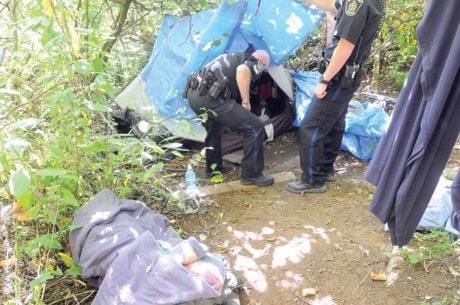Abbotsford has seen a dramatic decrease in homelessness, while most other Fraser Valley communities have seen numbers rise, according to the final report of the 2011 Fraser Valley Regional District Homelessness Survey.
Preliminary findings were released in April, and the completed report takes a look at the possible reasons why the numbers changed.
“That’s something we can’t explain at this point,” said Ron Van Wyk, the survey’s co-ordinator.
He noted the changes from 2008 to 2011 are significant, but could be a one-time occurrence. They can’t be considered a pattern until the next homeless study in 2014.
The report does suggest that Abbotsford’s drop could be the result of its stricter crime prevention strategy, and a city bylaw that prevents homeless camps from being erected.
“By encouraging people to move along, you are not helping the situation unless support is available,” said Van Wyk.
Abbotsford Police Const. Ian MacDonald said support is what local law enforcement provides.
“A lot of people don’t realize what options are out there for them ... some aren’t collecting the cheques available to them ... we try to connect the people with the resources.”
He believes the report is correct, and the closing of the camps has helped decrease the numbers, but they aren’t forcing people out to other communities.
MacDonald said before any homeless camp is taken down, police come days ahead of time and talk to the occupants. They offer information and resources to those willing to accept help and even post announcements of the day the camp will be dismantled. Often, police bring representatives from different service groups with them. He said many homeless people take advantage of the help available.
“We can’t force people to take it. Some of them refuse ....”
Those are the people Van Wyk is concerned about.
He credits the work being done in Abbotsford, and other communities, to create more shelter spaces and improve availability of affordable housing, but often it is those unwilling to accept help who are the ones who need it most.
“Drug addiction and mental health issues are significant factors in the number of chronically homeless,” Wyk said, and the B.C. government needs to continue to work with regional and local governments to respond to that challenge.
“The best way to deal with that is to provide housing with support.”
Van Wyk said people with mental health issues can’t simply be placed in shelters, or they will soon be back on the street. They need long-term support.
As for homeless people with drug addictions, the report recommends providing more “no-barrier” housing, a living space that offers, but does not mandate, drug counseling and other services.
Many shelters will not accept drug addicts who refuse counselling.
Abbotsford Coun. Patricia Ross, who is also chair of the FVRD, said the report raises multiple issues, especially the need for more detox facilities in the Fraser Valley.
She said there are numerous factors contributing to Abbotsford’s decrease in homeless numbers.
“You can’t look at just one factor,” she said, pointing out many groups are offering help.
“The Salvation Army has done such a great job ... they work with the person to discover the cause.”
She said the report shows all facets are working together to tackle the homeless issue.
“The first step is to identify the problem. We are well on our way.”
The number of homeless in Abbotsford dropped from 235 to 117 in 2011, and Mission’s dropped from 100 to 54.
Chilliwack increased to 111 from the 98 counted in a similar 2008 survey, from 12 to 20 in Agassiz-Harrison, and from 20 to 43 in Hope, a 115 per cent increase.
A total of 345 homeless were counted in the survey conducted in March 2011, compared to 465 counted in the 2008 survey and 411 in 2004.
Among the survey’s other findings are:
- homelessness is a result of poverty, unaffordable rental rates, family breakdown, mental health issues and drug addiction;
- nearly two-thirds are homeless for one year or longer;
- more women sought shelter in transition houses in 2011, rising to 34 from the 21 in 2008;
- more women were homeless in 2011, jumping to 45 per cent from 32 per cent in 2008;
- addiction was reported by 37 percent and mental health issues by 20 per cent;
- the majority of survey respondents (66 per cent) came from outside the region.
To download a copy of the full report visit:
http://www.fvrd.bc.ca/InsidetheFVRD/RegionalPlanning/Pages/AffordableHousingandHomelessness.aspx
– with files from Robert Freeman
